Red Fox Lab Traits, Appearance and Characteristics
The red fox Lab is a dark red shade of yellow Labrador Retriever. Brimming with intelligence, these affectionate, loyal dogs were originally bred as hunting companions. Red Labs tend to be from working lines. That means high energy, high speed, and a mountain of enthusiasm! These sensitive dogs are keen to please and responsive to training. Adult red fox Labs weigh around 65lbs, stand about 22 inches in height and have a lifespan around 12 years.
I’ll share photos of my red lab puppies as they grow from birth to maturity. The photo at the top of the page is their mother ‘Bella’ as a four month old puppy, playing in some wild daisies.
I’ll also share the breed traits, characteristics and behaviors you can expect from your red fox Lab puppy. I’ll talk about their growth and development, and give you training tips, and ideas to help you find a healthy, friendly puppy And we’ll have a go at tackling the genetics behind your stunning Labrador’s color.
- English vs American red fox Lab traits.
- Temperament and personality.
- Breeding darker red fox Lab puppies – the genetics.
- Red fox Lab puppy pictures week by week.
- Fox red Labrador breeders.
Fox red is a little more complicated to understand, than the other colors, but I’ll try to clear up any confusion. It’ll be fun!
Labs come in three colors, yellow, chocolate and black. Off the record, there are also dilute forms of those colors (champagne, silver, charcoal). The red fox Lab, or fox red Lab, is a dark coated variety of the full color yellow Labrador Retriever.
Is it Fox Red or Red Fox Lab?
The fox red Lab is sometimes called a red fox Lab, or a ruby Labrador. It doesn’t matter whether the fox or the red comes first. That’s a lot to do with the fact that fox red isn’t an official Labrador color. It goes down on record as a shade of yellow.
Of course, we know fox red is special! But from the AKC or KC’s point of view, it’s just another yellow dog. The selection of darker red Labrador Retrievers by breeders has increased as darker puppies become more popular companions than paler yellow Labs.
A Good Family Pet
Like all Labradors, this fox red Lab can be a great companion. Their energy levels are best suited to active owners, and families with older children. Youngsters can be clumsy and boisterous, but a senior rescue dog may do well alongside younger children.
Thorough training is important for your red fox Labrador puppy. And you are looking at one to two hours exercise each day once adult.
Labradors are some of the world’s most popular hunting companions in addition to their wider roles as service dogs, and most red fox Labs love to explore outdoors and to swim.
Fox Red Lab Origins and History
All three colors of Labrador Retriever, black, chocolate and yellow (including the red shade), share the same origins or history. The Labs we have today descend from the St John’s dog, a breed of working fisherman’s dog that gave rise to the Labrador Retriever, and, the Newfoundland. Labradors were developed as hunting companions and retrievers by a couple of British aristocrats in the 1900s.
At one time, almost all Labradors were black but the potential for red fox Labs has always existed. Chocolate and yellow Labs were less common (I’ll explain the genetics below) and yellow or brown puppies were often culled at birth!
Nowadays most Labs are companion dogs, and yellow and chocolate Labs are no longer considered undersirable. And this popular dog breed has now spread across the world.
Red Fox English Lab vs American Lab
In the 1970s the trend in yellow Labradors swung to pale cream colors. Especially in the show and companion dog community. A pool of dark yellow or fox red Labs remained popular in the sporting dog community. Possibly because a pale dog, easier for wildfowl to spot, is not an ideal hunting companion.
During the middle of the twentieth century in the UK, the Labrador breed became divided into the the two types of Labradors we have today, the working type we refer to as American Labs and the show type we refer to as English Labs. As red Labs were more popular with hunters, it is largely from the pool of working retrievers that we now have the stunning fox red Labrador Retrievers that we see today.
Red American Type Labs
Because they are often American type Labs, red Labs may be taller and more athletic in appearance than the paler yellow Labs.
American Labs have a slimmer build, with narrower heads and chests than show Labs. They have a stronger prey drive, and are a little less forward and playful.
Red Fox Lab Temperament
Many red Labs will have the friendliness and outgoing personality typically associated with Labs. An abundance of intelligence, a sensitive nature, and a spirit of co-operation make this an easy breed for you to train.
But, the sensitivity of the fox red Lab can in some cases spill over into reactivity. Including nervousness, and fear of strangers. These traits can sometimes appear in your dog even after thorough socialization. So it’s important you make careful choices when looking for a breeder.
English Red Fox Lab
If you want a typical English lab with the stocky body and blocky head, you’ll need to look for a dog with a show background, or at least some show blood in their pedigree.
Fox red Labs are mainly the preserve of the working retriever community, so you may find it a little more difficult to get an English fox red lab puppy.
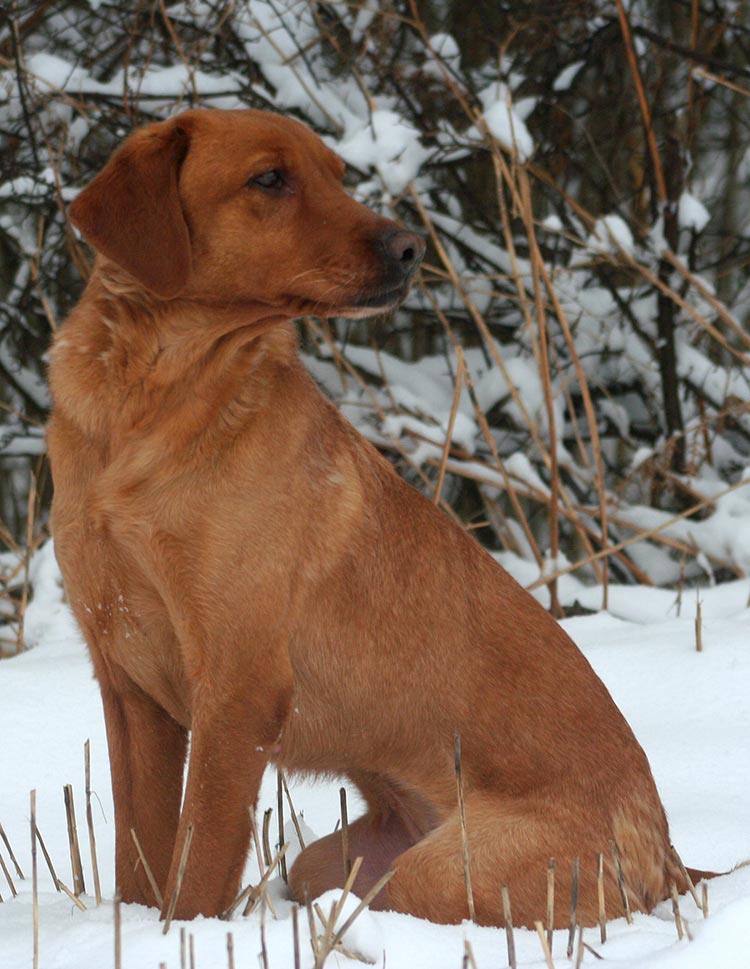
Breeding Darker Red Fox Lab Puppies
Many of the fox red Labs we see today are darker than ever, as breeders select for deeper coat color in order to increase puppy sales.
In any yellow Labrador litter you’ll get a range of colors. Selection based on color narrows the gene pool available to the breeder. With pressure on breeders to select darker individuals for breeding stock, there’s a risk that health credentials, performance credentials, and temperament get pushed into second place.
Breeding puppies of a particular shade of yellow, is also complex, because of the mechanism of inheritance.
Fox Red Lab Genetics – Black & Brown First
Genetics can be complicated, but I find it helpful to think of a Labrador as a basically black dog. Black is the default color. The black coat is caused by a pair of genes called the B genes
- Your dog inherits one from their mother and one from their father – in a pair – like this: BB
- B genes come in big or little versions. So your black dog could have a pair like this: Bb
- Little b carries the code necessary to make a brown coat instead of a black one. BUT, big B is dominant and switches off little b.
- So little b only gets a say, if two of them get together like this: bb. When that happens, you get a chocolate Lab!
Red Fox Lab Puppies Are Genetically Yellow
To get a fox red lab, you need to switch off the black and brown coat color genes. This is done by two e genes. They also come in a pair like this: ee.
A yellow dog is still basically black or brown, but when the two little ee genes get together they have the amazing power to block the effects of the B genes on fur color.
A lab with two little ee genes cannot have a brown or a black coat and so the coat color now defaults to yellow. Now we are getting closer to our fox red color.
E genes can also be big like this: EE or mixed like this: Ee, but when that happens the big E switches off the little e, and takes away its power. This renders the little e gene useless and it can’t then in turn switch off the brown or black coat color.
So you’ll get a black or brown dog unless those two little ee genes get together to switch off the B genes and give you a yellow dog.
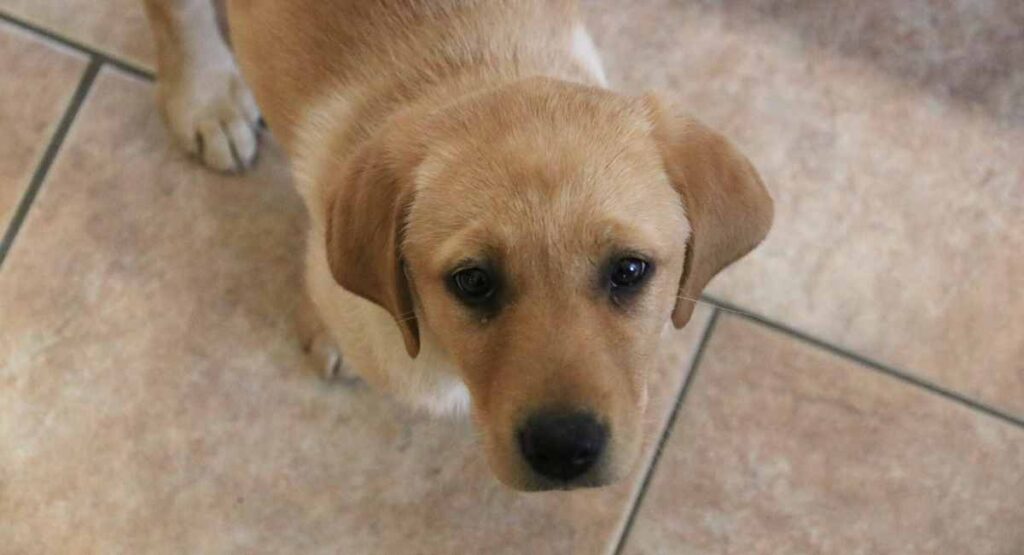
Yellow vs Red Fox Lab Coats
A red Lab is a variation of yellow, and every red dog has those two essential little e genes that switch off black and brown. But then it starts to get a little bit more complicated.
It centers on a pigment called pheomelanin. This pigment is responsible for the depth of red coloring in the yellow lab’s coat. And it is controlled by two more sets of genes.
Red Fox Lab Genes
The A gene controls the production of the red color. And the C gene controls whether or not it is fully expressed. These two different pairs of genes interact together to give us a range of different shades, from pale cream to rich fox red.
It isn’t just a question of switching the red color on or off. In fact, I am over-simplifying things.
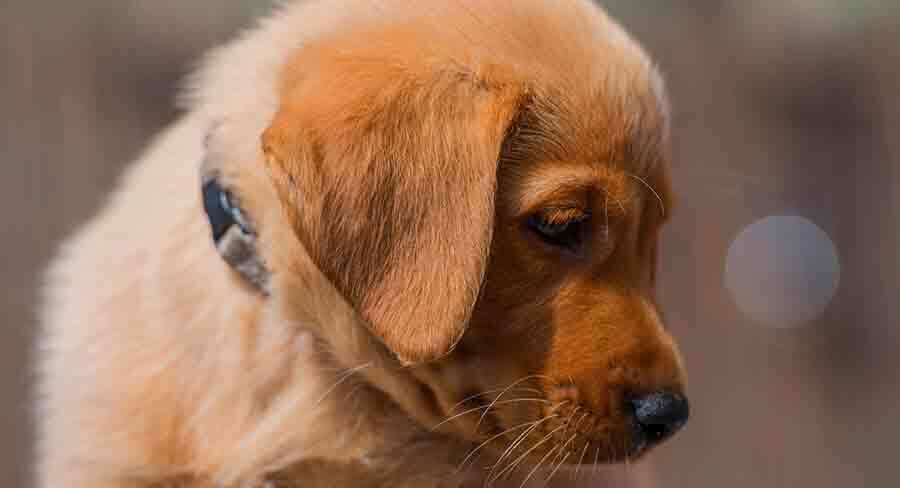
Dogs have other genes involved in coat color, some of which affect the Labrador. Genes, for example, that control areas of darker shading which can cause that ‘saddle’ pattern on some yellow dogs. But let’s not go there today!
Remember, you’ll only see the effects of the interaction of these more complex genes involved in producing your lovely fox red lab if the ee genes are present as a pair.
Fox Red Lab Breeders
Your first step when bringing any Labrador into your life is to make sure that this is the right time. The next step is to find a reputable breeder of Labradors.
Finding a nice fox red stud dog and making a list of recent matings is a good starting point. Color is not the top priority for a responsible breeder so you are unlikely to find a good breeder who only breeds fox reds.
No breeder can guarantee you the final color of your puppy. In most yellow litters there will be a range of shades. Puppies may darken as they grow, or they may not.
For your pup to have the best chance of growing up healthy, both parents must have good hip and elbow scores and a clear eye test, as well as a PRA clear certificate. Check with your veterinarian for a further list of current tests required for Labs as these increase and change over time
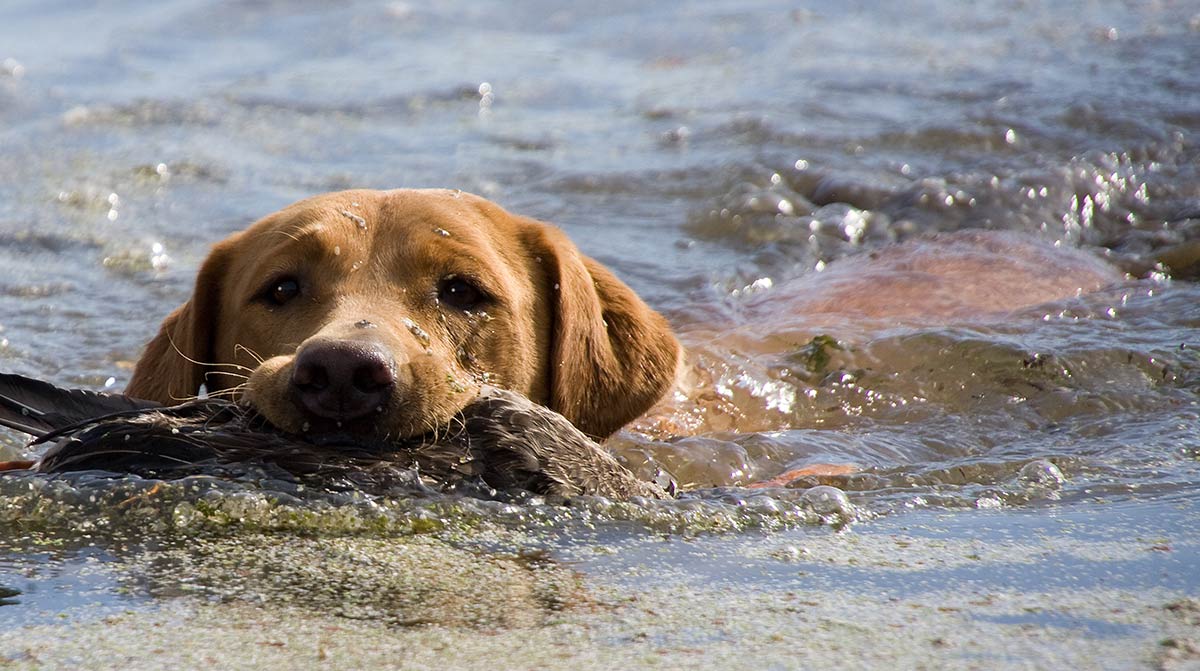
Red Fox Lab Puppy Prices
Fashionably colored dogs can be expensive, and this is happening to some extent with reds. My advice is to be wary of paying an unusually high price for a red Lab puppy. An unscrupulous breeder may be cutting corners on health or other important matters.
Most respected breeders sell puppies of different colors for the same price irrespective of color, and a healthy pup from a well established breeder is usually your best option.
Fox Red Labrador Puppies
Fox red Lab puppies are noticeably darker at birth than the average yellow Lab. Here is my dog Bella’s litter soon after they were born.
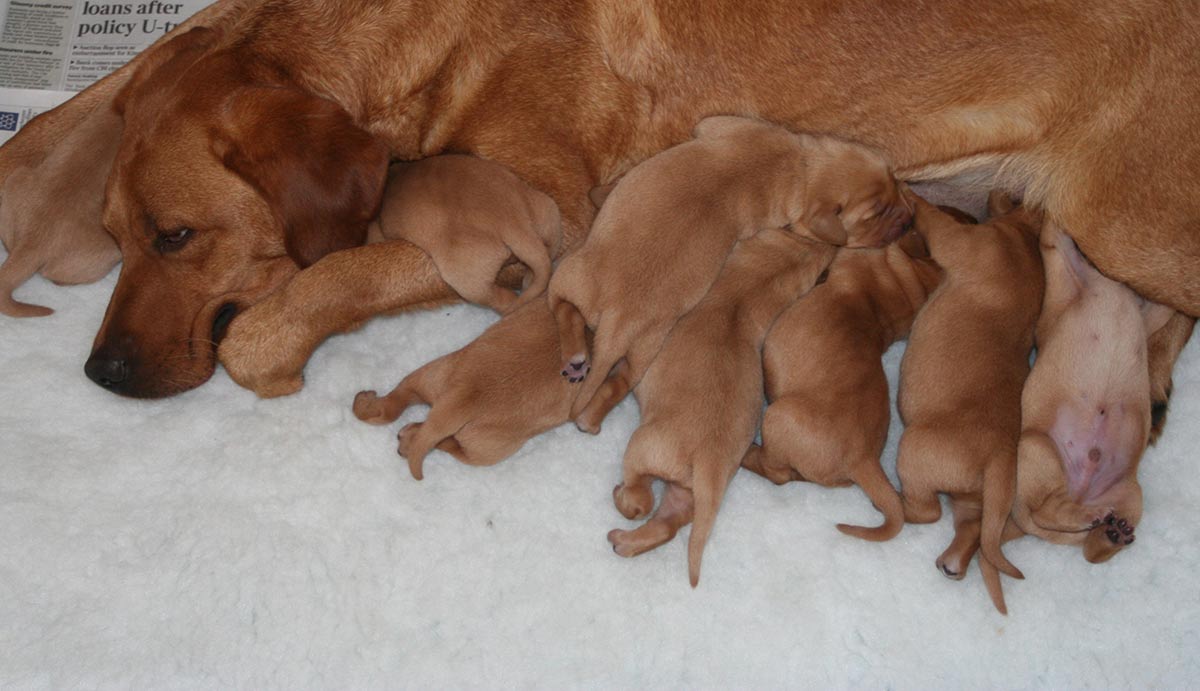
This shade darkens over the first few weeks.
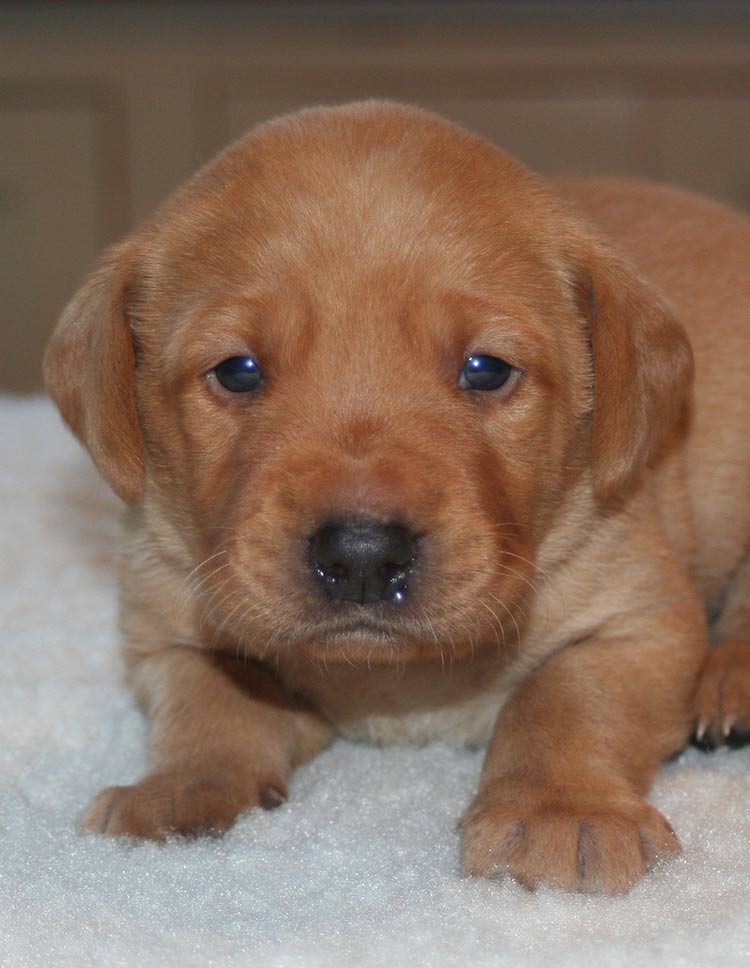
By three weeks old your puppy is starting to look more like a Labrador.
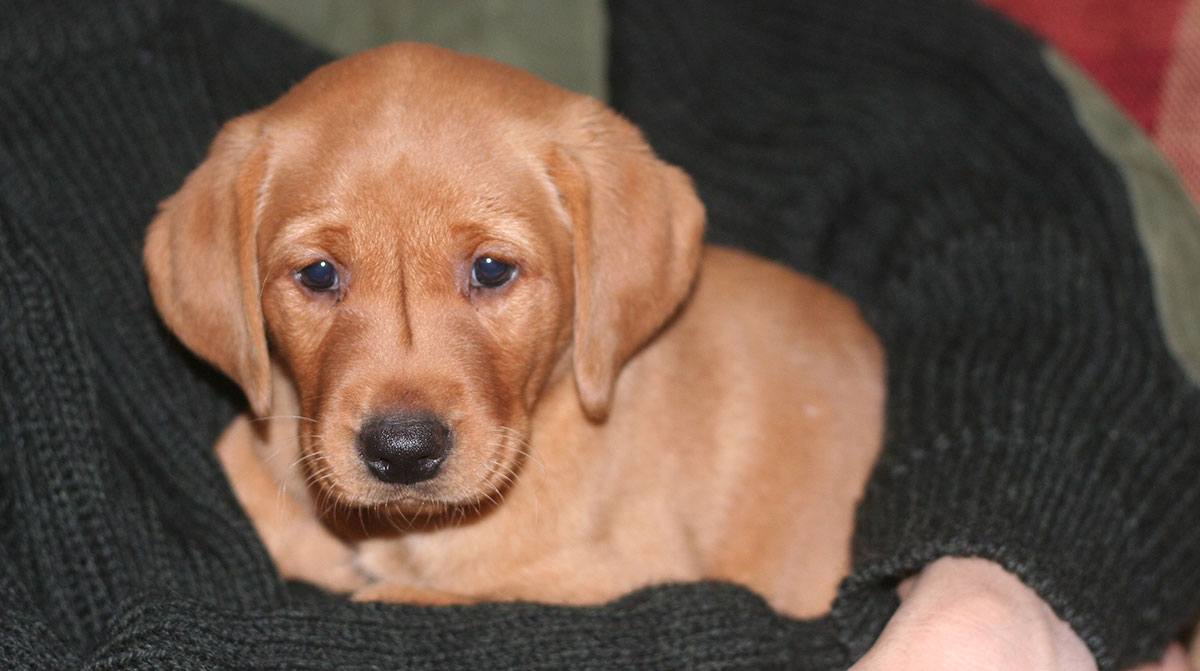
By the time you take them home at 8 weeks old they will have that lovely fox red shade.
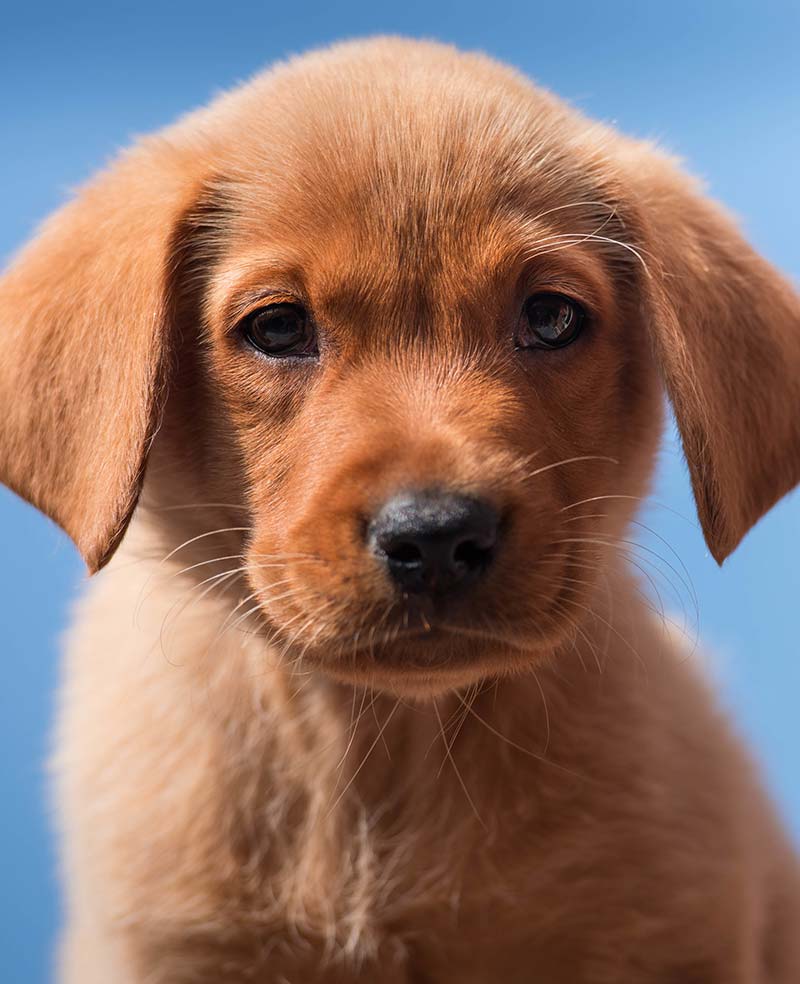
Your brand new 8 week old red Lab puppy will need frequent meals, close supervision, and plenty of socialization. Those first few weeks can be busy ones. You’ll find lots of resources on this website to help and support you as you raise your new puppy.
Exercising Your Puppy
Exercise is important, but small puppies don’t need long walks. Start off with no more than a few minutes of formal exercise a day from about three months of age. And work up to any big walks or runs very gradually over time. Check out our puppy exercise page for more information
More about Labrador Types and Colors!

Free Labrador Updates!
Get my training tips, news, reviews, and the latest from The Labrador Site delivered to your inbox



We have a Red Lab that is also a Dudley, pink nose, lips, pads, and around his eyes. He has a very good temperament and love everyone and everything.
I really enjoyed the article on red labs.
Thanks
Can we look at red lab fox with Mac and teal.
We rescued a puppy last year and was told it was a Plott hound which we didn’t care what it was because we fell in love with her the second we saw her, our Vet did a DNA and it can back Australian cattle dog and Great Pyrenees. But our Molly, dog is solid red with no white at all, she has a lot of the temperament of the cattle dog but she also has so has the temperament of a Labrador, not that it matters but I wish I knew what she really was. I loved the read on the Red Fox Labrador it sounds alog like molly.
Hello! What are these pictures cute! I just can not! I love looking at pictures of little Labradors so much! These are simply some of the finest dogs in the world! And especially this photo of the smallest Labrador! I remember the day when I was presented with a Labrador, I was so happy that it is simply beyond words! I wish everyone had a dog in the house)) and preferably a Labrador! Thanks for such a lovely post! It was interesting to read it!
Hi Pippa
I was really interested in your article about the fox red labs. Is it genetically possible for a fox red and a chocolate lab to have only yellow and black pups?
If the chocolate has to have bb, and the fox red has to have ee. Won’t the the pups have ‘be’ genes which the b would override the e and the litter would be all black?
Ok got it. It’s just another Labrador that some people think is unique because of it’s color, but a Labs still a Lab and has all the same genetic problems as any other Lab. When you start breeding for a specific trait you reduce the gene pool. Leads me to believe I’d be better off just taking the luck red find than finding someone who breeds only for the trait.
Hi Pippa,
My name is Dianna, and I had a developing problem. I have had diabetics for 10 years now , and it is starting to give me the problems my Doctor warned me about. I will be having an infected toe-nail removed soon and my eyes are starting to blury up. I pray I don’t lose my total sight. But it will be Gods will not mine.
I have also had 5 back surgeryd and may be facing another. (you can tell I had avery active life) and I want to continue to be as active as I can, I had trained a Golden retriever for the see-I foundation and he was place with a very nice man.
I have raised three Labadores, two German shapers and two Shitzus I have to be honest I loved all of them they are all great dogs. But now I would like a Labadore and I wil be thrilled to take a pup and train her/him for my special need. even if I am able to keep my sight I have the other issues that a service dog will be perfect for.. I have had a white lab, a goden and a black. I have recently didcovered the Fox Red this is the color I want. I love red and a deep red is very apealing to me. I realise there are easer and less expensive dogs but as you know once a lab lover always a lab lover . All my desting will begain next week to find out judt how mych damage my Diebieties has done and back issues. I know it will take me awhile to locate a pet Fox Red, But I thought you might be able to help me down the road to find my SYDNEY.
Thank you
Great article and learned a lot about the labrador.
We have a brown one and a fun dog in many ways. Nearly a year after we got our dog we learned from vetrinarians that the colours also tells a bit about the dogs behaviours / temperament.
Yellow: Calm and collective dogs. Which is the reason why these are often used as seeing eye dog.
Black: calm and collective dogs, but maybe a bit more lively.
Brown: Definitely more lively …
One said that brown labs are not used for hunting in England because they cannot sit still…
Our dog has a great nose and so we do long “nose work” trails in the forrest. Or make him find stuff in the house.
Can anyone help me answer this question ASAP! I have been to see a litter of puppies and they are from working dog breeds and are black. In the litter there were 3 small females age two weeks and two large females. I was wanting to choose one of the small females, but they have all been chosen. When they grow up will they all be the same size? Will the small females catch up with the larger females, or what you see is what you will get? The mother is slight and the dog is a muscular working dog. I would really appreciate someone helping to answer this question!
Don’t go by the size of the puppies, especially when they are young! I had a litter where the runt wound up being the largest dog out of the bunch. And it was a VERY small puppy. Half the size of its siblings. The largest female wound up being the smallest out of the whole litter. So definitely don’t worry about the size of the puppy when you get it.
we have got cleo 2 weeks a got what a great dog I have had retrievers but this fox red is a beautiful dog
Just recently adopted a 9 month old from a shelter. She has a Fox red color with a huge splash of white on throat and chest. They said she is a lab/Shepard mix. I have a few photos of her. If anyone can help me try to identify her general breed so I can look out for specific health issues. She’s a beauty. A lil leash aggression and under socialized with other dogs. But hopefully with time and love she will over come it. 🙂
Ours is a pure bred red fox and she has a white diamond on the chest. It is a common trait with red fox
We just put our red fox down … 6 years young and I’m devastated. She brought my sneakers every morning so we could begin our daily walk. She helped on wash day bringing some clothes to the laundry room and picking up all the socks I dropped along the way. She helped on food shopping day carrying in the smaller items from the car. Ever since we got our fur baby I never had to pick up anything I accidentally dropped. Sonny was always there and would come a running to assist me.
Love your red fox babies, they are precious.
Our Fox Red is a English lab and also has the pink nose. We adopted her from a breeder and she is 7 yrs old. Tremendous temperament. Very sweet dog.
Hi Karen
That sounds like exactly what we’ve been looking for. Can you give me the name of the breeder? That would be really helpful.
Interesting article, thank you! I’d never heard of a Fox Red Lab until today. Out and about with our 14 week old pup Bella! Several people commented on her colour, asking if she was a Fox Red. I smiled politely and quickly changed the subject, not knowing what they were on about! I now know our Bella is also a Fox Red and I can explain the genetics next time someone asks! Thanks ?
We had been yearning for a lab puppy, preferably black female so we started looking. We found a litter of the age we wanted, almost 8 weeks old and only one black female left. They sent us pictures and at that point there were only 2 left so we went to check on them. Well with a male red fox, and black female we just couldn’t split them up. So now at at 9 months it’s like having 2 “ Marleys “ and wouldn’t have it any other way. They keep us so busy, they keep us young as we are in our later 60’s. Have always had labs and you never will find two alike, they all have their own personalities.
Our new best buddy, Jake, is 13 weeks old and weighing in at 28 lbs! He is a sweet boy, and I still find myself coming back to this reference page to read about him and his fascinating genetics. Thank you so much for the information. Such a great and informative read!
Just chanced on your great informative article on fox red labs. We have just sadly lost our 12.5 year old American-type black lab and would like to find a breeder for a fox red male American-type puppy, we live in Hampshire, can you recommend any? Thank you.
We have had 2 labs, choc & black. They are getting older & really want another one. I just discovered the red fox & love!!! I thought the article would give me an idea of price but didn’t see any price suggestions. Any suggestions where to start to find our next new puppy? We live in MN. Also, price to expect? Would love a female. TY!!
I am in the market for an ~ 1 1/2 to 2 year Fox Red Registered female. If anyone can provide assistance, I would greatly appreciate it.
thanks – Pat Smith in McKinney, Texas
Great article.. Love my Labs. I have a male dark red British Lab and a yellow female sired by Tweedshot Trimble of Lettergreen. Both great hunting dogs and family members.
Great article, thank you. Now I know how our gorgeous red fox lab Ruby came to be as she is. She was the first in our village as far as we know, but now there are several. Sometimes complete strangers ask to have their photo taken with her. It’s like going on walks with a celebrity. Her parents are both Scottish. Another owner (who had the identical dog to ours, also called Ruby – luckily they knew their owners!) told us last year that many of the reds in the UK come from a breeder in Perthshire, Scotland. Her father is one of them.
Thank you for the great article!! I first fell in love with fox reds with my first breeder rescue! I just got my second fox red who is a 9 year old english. Love her fire red hair and white face.
I now know we have a beautiful Fox Red Lab!
We got him as a rescue, he was already 3 or 4 years old, and we have now had him for 4 years, he is getting so gray now…but nothing slows him down! When he came to us he had a broken rear leg that required a pin, the pin shifted and caused nerve damage so it was removed, but he wouldn’t put weight on it anymore. We then had to work with him to get him using it again, swimming, acupuncture and physio – you can still tell it isn’t quite 100% but he doesn’t let it stop him.
We were told he was a lab mix, some people said he was crossed with a Ridgeback, I thought maybe he was crossed with a Vizsla…but now I have no doubts he is a Red Fox Lab. I first thought he was a red fox lab when I came across a book “Daisy’s Gift” by Claire Guest (amazing book well worth the read!) The picture of Daisy on the front is the exact image of our boy Fozzie, so I did a search and came up with this article and I am so glad I did, great article!
Not many people know about the Red Fox Lab, and I am guessing that they are rare here in the United States?
Our Fozzie is the American type for sure and I think that maybe he may have been someones gun dog (through x-ray it was discovered that he was shot in the leg at some point, the pellet is still in his leg, I am hoping this was an accident while out hunting, and not someone deliberately shooting this sweet boy!)
He is such a wonderful dog, so smart and so loving, gets along with everyone, won’t stop chasing a ball ever…I’m so glad he came into our lives!
Hi
We live in new york and we are desperatly looking for a Red Fox ENGLISH LAb
Any suggestions?
Thanks so much…loved your article
Thank you for such an informative article. So many folks have never heard of a fox red lab, and have questioned my dog’s breed.
We have a sweet, beautiful, 6 year old fox red girl. She’s the smartest dog I’ve ever known. Her grandparents were bred at Wild Rose, but she came from a very loving home in Birmingham, AL, where her parents both lived.
She is the perfect family dog, and is also an excellent hunting companion for my husband. We laugh about how she has no problems jumping into wet, cold marsh to retrieve a duck, but if it’s raining out, she refuses to get her feet wet.
Also, she has been a wonderful playmate for my 12 year old daughter, who is our only child still living at home. She would be otherwise very lonely, as her older sister left for college a few years ago. The two of them spend hours in the pool in the summer. They’re both like water bugs!
Best dogs ever!
have seen some 5 day old pups where mum is black and sire was red fox. there are 3 black pups and 4 which are a fawny colour. is this quite normal for the red fox shade so will it change in time?
I have seen a litter of labrador pups from a black mother and red fox sire. The pups are 5 days old 4 black and 3 beigey coloured. I want to know whether these unusual coloured fawny ones will definitely turn reddish because that is what I hope for. can someone please e-mail me back to my address as I don’t know how to look back into this.
We have a beautiful fox red male lab who is now 4 months old. He came from an excellent breeder of this breed/colour in Rotherham. He is an absolute delight, very smart and easy to train, fantastic with people, other dogs and children. We are so pleased to have him in our family. You will love your puppy.
Carol i couldn’t disagree with your trainer more! We have a 2 year old red girl from a very responsible breeder of working labs. She is incredibly sociable and friendly whilst also being very calm and chilled and loving. She was easy to train and is very responsive to ‘working’ for her food and toys with sniff and search games but doesn’t go mad when out for walks and so on. She is great with kids of all ages and has been into school with my teacher-wife many times, but doesn’t bat an eyelid at just being calm and friendly with grandparents etc. It ‘s a great shame your trainer has unsettled you before you even get your new pup. The temperament of the parents will be a key to how your pup will naturally be and then training will take care of the rest. Enjoy!
Hi Carol,
I’m very sorry to hear that this dog trainer upset you.
Working dogs tend to have more ‘drive’, so more instinct for fetch and interest in the wildlife. Show dogs tend to have a bit more ‘bounce’, so more social with people and perhaps therefore more lively in this respect. They are both different, but both lovely.
You can find out more about the difference between working and show lines here: https://www.thelabradorsite.com/which-type-of-labrador-makes-the-best-pet-work-or-show/
You could also join the Labrador forum here, https://thelabradorforum.com/ where you will get to chat to owners of show and working dogs who will be happy to advise you further.
My family’s working lines fox red Lab is an older lady now, but she has always been one of the most chilled out, keen to please, loving dogs you could ever hope to meet.
I hope you enjoy your wonderful new puppy. Lucy.
We adopted our Clancy two years ago from the local SPCA. I had never known there were red fox labs and they told us he was a lab mix. He is the most intelligent, gentle, easily trained dog. A co-worker just got a “red lab” so I investigated further. This is our Clancy! We still cannot believe how blessed we have been with him. Thank you for your info!
Hello, my puppy was born chocolate and two months later changed to this red fox color, who that possible?
My dog has always been a really dark color for a yellow lab, which is what I was told she was. For the longest time I thought the breeder lied and she was really half lab and half golden retriever. But I am so glad I came across this article because I didn’t know there was a fox red breed. She isn’t as dark as your Tess but she isn’t your typical light yellow lab either! She even has the American lab stature and nose!
Thank you for this article!
I bred a pair of black labs and two of the puppies were fox red. I had two different vets tell me that the red ones were not true labs!! That another male dog had mated with our female. We knew that was impossible since she was either in our house, pen or outside with us. I truly enjoyed reading this article!
Who Knew! I have a 9 year old male who is this color, and additionally, his tail stands up, and curls towards his back. I also have a chocolate lab which is almost auburn; I refer to them as ‘Milk Chocolate, and Dark Chocolate’. I am in the USA, Arizona – the ‘fox color’ was bred in Utah, the dark chocolate was bred in Arizona. My ‘fox color’ male is the gentlest of all of my labs – I have had 5, and my dark chocolate lab had an ‘attitude’!
Glad you enjoyed the article Paul. It’s great that Molly is still enjoying life at 14 🙂
Lovely article. Our gorgeous fox red lab Molly is now 14 and still in good spirits. She was bred by our daughter’s (then) boyfriend’s uncle and her boyfriend also took a dog from the same litter. This dog (Figo) is more your typical Andrex puppy. We always wondered why there was such a difference in colouring between the two dogs.